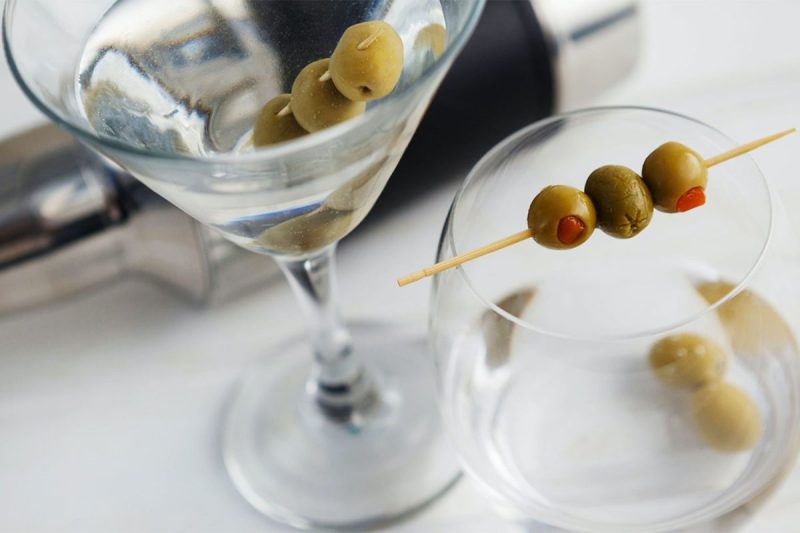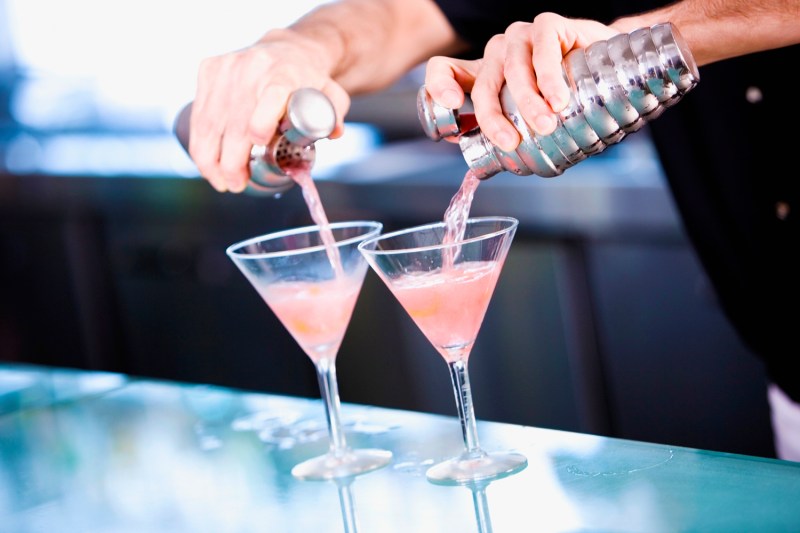The martini is a beloved cocktail, but it’s hard to order one like you know what you’re doing. That’s because it is a drink that can come in so many forms, and everyone has their own preference for what they like best. There is more than one way to make a martini, and crafting a martini the “proper” way is a subject of debate. Does a martini have to employ gin or vodka? Will the Martini Police pop up out of nowhere if you use vodka instead of gin?
The truth is, neither is wrong. Shocking, right? We know you have a lot of questions, so we spoke with former master mixologist of Beam Suntory, Bobby Gleason, to find out the origins of the vodka martini — a popular twist to the gin martini. And later on, we’re going to learn how to make the best vodka martini in the whole galaxy. Trust us, it’s one of the easiest cocktails to master and is perfect for those who want to enjoy a refreshing vodka-based martini without the botanical flavors of gin.
Classic vodka martini recipe

Ingredients
- 3 ounces of vodka
- 1 ounce of dry vermouth
Method
- Add vodka and vermouth to a mixing glass with ice, and then mix well until the sides of the glass are cold.
- Strain into a martini glass.
- Garnish with an olive or a lemon peel.
The art of the classic vodka martini is to keep it simple. The recipe calls for just two ingredients — vodka and dry vermouth — plus the garnish of your choice. You’ll note we called for it to be stirred, not shaken. That’s because shaking creates little slivers of ice that give the drink a cloudy appearance. By stirring the drink, you get a clearer look which has a certain elegance to it.
How to make a vodka martini

If you’re new to making a vodka martini, we’ve got some tips and tricks for you to ensure that the first time you make one, you will basically feel as suave as 007. First, you need to decide on the type of vodka you want to use. For Gleason, “a clean, pure wheat-based vodka such as Pinnacle Original will meet even the most discerning drinker’s needs for a vodka martini. For a more robust martini, Pinnacle 100 Proof is my choice for a shaken vodka martini, as the extra level of proof will stand up to the shaking of the ice.”
From there, you need to decide on what vermouth to use and how much to use. “The amount of vermouth is a personal choice, and for me, I like the herbaceous flavors of a quality fresh vermouth and will go with a 3 or 4 to 1 ratio, stirred, and served up,” Gleason said. The most important things to remember when picking a vermouth, according to Gleason, are:
- Buy quality: Saving a little on the vermouth will lead to a lower-quality cocktail.
- Buy small: Vermouth is a wine-based product and should be handled like a wine. Start with a 375 ml bottle. If you can use that within a week, go to 750 ml.
- Cap it: Always put the cap back on a bottle and never put a pour spout in it.
- Chill out: Most importantly, keep it refrigerated.
When it comes to the shaking or stirring argument, here’s what Gleason had to say: “When preparing a martini that contains ingredients such as citrus or egg whites, shaking is a must. This introduces bubbles and the end result is a delicious, frothy concoction. For spirit-forward martinis, stirring is essential as it ensures the drink isn’t too watered down.”
Finally, we’ve got the how-to for all those variations mentioned above. By following a simple formula — 2 parts vodka, 1 part modifier, 2 parts juice, 1 part sweetener — you’ll be able to create any type of flavored vodka martini. Here’s an example:
Sweet vodka martini recipe

By Master Mixologist Bobby Gleason, formerly of Beam Suntory
Ingredients
- 2 parts Pinnacle Original Vodka
- 1 part orange liqueur or triple sec
- 2 parts fresh lemon juice
- 1 part simple syrup
- 1/2 part egg white
Method
- Shake all ingredients with ice and strain into a chilled cocktail glass.
- To add more depth of lemon flavor, substitute a limoncello for the orange liqueur.
Now that you know the history of the vodka martini and have the tools to make your own, it’s time to go forth and savor this iconic cocktail.
Drink like Bond: The Vesper martini

We all know James Bond drinks vodka martinis, but did you know that in his first appearance in Ian Fleming’s Casino Royale, he ordered a martini made with both gin and vodka? Here’s the specific order Bond gives in the 2006 film:
“Just a moment. Three measures of Gordon’s, one of vodka, half a measure of Kina Lillet. Shake it very well until it’s ice cold, then add a large thin slice of lemon peel. Got it? … This drink’s my own invention. I’m going to patent it when I think of a good name.”
Later in the book, Bond meets agent Vesper Lynd, and he names the drink after her. The Vesper only appears in the first Bond novel since (spoiler alert) Vesper dies in the book, and Bond never drinks it again.
Still, in the real world, the Vesper martini has remained popular, even though the recipe has evolved over the years, mostly because Kina Lillet is no longer made. Here’s a modern take on the Vesper from Liquor.com.
Ingredients
- 3 ounces of gin
- 1 ounce of vodka
- 1/2 ounce of Lillet blanc apertif
- Lemon twist for garnish
Method
- Pour the gin, vodka, and Lillet blanc into a cocktail shaker filled with ice.
- Shake for 20 to 30 seconds until the mixture is ice cold.
- Strain into a chilled cocktail glass.
- Express the oil from the lemon twist into the drink, rub the twist around the rim of the glass, and drop the twist into the drink.
The history of the vodka martini

“After World War II, Americans began celebrating all things and cocktails were a big part of that. Gin was still a popular spirit (No. 2 to whiskey) and many of the classic cocktails were based on gin. As vodka became more readily available, marketing carried vodka to new heights,” Gleason said. “In 1950, around 50,000 cases were sold and by 1955, that number reached over 5 million. By 1967, vodka sales exceeded that of gin and in 1976 surpassed the sales of whiskey.”
With so much vodka flooding the market, bartenders needed a way to use it. The simple idea was to replace gin with vodka. The Orange Blossom became the screwdriver and the martini, when made with vodka, was originally called the kangaroo cocktail. (Details on the origin of this name of sketchy at best. Bobby Heugel, who wrote for the Houston Chronicle in 2010, said the name was given when “vodka was first being imported.”).
The biggest influence on the vodka martini’s popularity, though, Gleason said, was the spy of spies: James Bond. The vodka martini was first seen in the 1956 novel Diamonds Are Forever (previous to this appearance, author Ian Fleming used gin), and the famous direction, “Shaken, not stirred,” came two years later in Dr. No. Another icon in pop culture, Jeannie in I Dream of Jeannie, also used vodka martinis (making them gush from a rock for Captain Nelson). It was, thanks to pop culture, the drink to be seen with. As far as the garnish, that, too, evolved.
“The lemon peel makes way for the olive. One olive becomes two, then three as glasses kept getting bigger. Then those olives were stuffed with pimentos, blue cheese, hot peppers, caviar, and whatever else you could put in it. Eventually, olive brine was added (olive juice is oil so it doesn’t really mix with vodka),” Gleason explained.
And the rest, as they say, is history. The vodka martini has grown and developed over the years into one of the more popular classic cocktails out there, with as many variations as there are olives in Italy.




